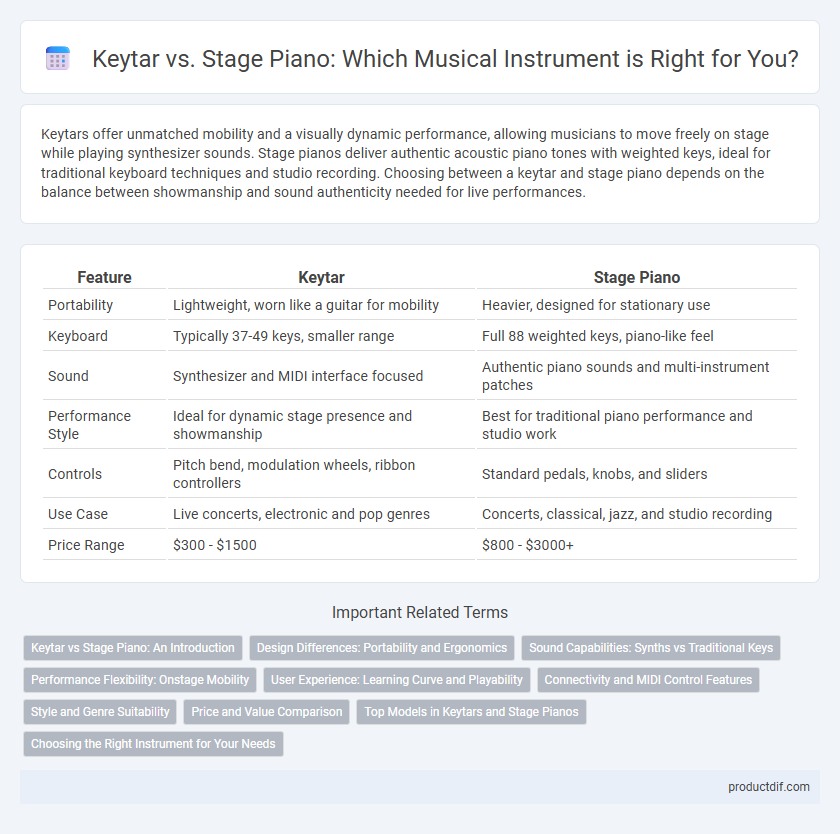Keytars offer unmatched mobility and a visually dynamic performance, allowing musicians to move freely on stage while playing synthesizer sounds. Stage pianos deliver authentic acoustic piano tones with weighted keys, ideal for traditional keyboard techniques and studio recording. Choosing between a keytar and stage piano depends on the balance between showmanship and sound authenticity needed for live performances.
Table of Comparison
| Feature | Keytar | Stage Piano |
|---|---|---|
| Portability | Lightweight, worn like a guitar for mobility | Heavier, designed for stationary use |
| Keyboard | Typically 37-49 keys, smaller range | Full 88 weighted keys, piano-like feel |
| Sound | Synthesizer and MIDI interface focused | Authentic piano sounds and multi-instrument patches |
| Performance Style | Ideal for dynamic stage presence and showmanship | Best for traditional piano performance and studio work |
| Controls | Pitch bend, modulation wheels, ribbon controllers | Standard pedals, knobs, and sliders |
| Use Case | Live concerts, electronic and pop genres | Concerts, classical, jazz, and studio recording |
| Price Range | $300 - $1500 | $800 - $3000+ |
Keytar vs Stage Piano: An Introduction
Keytar and stage piano are both versatile musical instruments favored by performers for live shows and studio sessions. The keytar combines the mobility of a guitar with the functionality of a keyboard, allowing musicians to move freely on stage while playing synth sounds and MIDI controls. In contrast, stage pianos prioritize authentic piano sound and weighted keys, making them ideal for traditional piano performances and more stationary setups.
Design Differences: Portability and Ergonomics
The keytar features a lightweight, strap-worn design that allows performers to move freely on stage, enhancing portability and dynamic interaction with the audience. In contrast, stage pianos are bulkier, designed primarily for stationary use, offering a traditional piano keyboard experience with greater weight and size limitations. Ergonomically, the keytar emphasizes mobility and ease of play while standing, whereas stage pianos prioritize stability and tactile feedback suited for seated performance.
Sound Capabilities: Synths vs Traditional Keys
Keytars excel in synthesizer sound capabilities, offering a wide range of customizable tones, effects, and modulation options that enhance live performances with dynamic, electronic sounds. Stage pianos deliver rich, authentic traditional keyboard sounds, including grand piano, electric piano, and organ tones, prioritizing acoustic realism and expressive touch response. Musicians choose keytars for versatility in synth-based genres and stage pianos for high-quality, classic keyboard sounds in more traditional settings.
Performance Flexibility: Onstage Mobility
The keytar offers unmatched onstage mobility with its lightweight design and strap, allowing musicians to move freely and engage the audience dynamically. In contrast, stage pianos prioritize authentic piano feel and sound but require a stationary setup, limiting physical movement during performances. Choosing between a keytar and stage piano depends on whether dynamic stage presence or traditional keyboard expressiveness is the primary performance goal.
User Experience: Learning Curve and Playability
Keytars offer a more intuitive playability for performers who prioritize mobility and expression, with a lighter learning curve due to their simplified interface and MIDI compatibility. Stage pianos provide a comprehensive tactile experience with weighted keys and extensive controls, appealing to pianists focused on traditional technique and dynamic range. User experience varies as keytars encourage movement and stage presence, while stage pianos emphasize precision and depth in sound manipulation.
Connectivity and MIDI Control Features
Keytars offer wireless MIDI control and USB connectivity, enabling seamless integration with digital audio workstations and live performance setups. Stage pianos typically provide extensive MIDI implementation with multiple input/output ports, allowing connection to external sound modules, controllers, and computers for comprehensive control. Both instruments support advanced MIDI mapping, but keytars emphasize mobility while stage pianos prioritize robust, stationary connectivity.
Style and Genre Suitability
Keytars excel in genres like synthpop, funk, and rock due to their mobility and visual stage presence, allowing performers to engage audiences dynamically during live shows. Stage pianos are preferred in jazz, classical, and pop settings for their authentic piano touch and rich sound, delivering superior tonal quality suited for traditional keyboard roles. Each instrument's design aligns with distinct performance styles, making keytars ideal for energetic, showmanship-focused acts and stage pianos better for nuanced, expressive playing.
Price and Value Comparison
Keytars generally offer a more affordable entry point, with models typically ranging from $300 to $1,000, making them accessible for performance-focused musicians seeking portability and stage presence. Stage pianos, priced between $1,000 and $3,000 or more, provide superior sound quality, weighted keys, and comprehensive features, delivering greater value for pianists prioritizing authentic playing experience and versatility. Evaluating price-to-performance ratio depends on user needs: keytars excel in live expressiveness at a lower cost, while stage pianos justify higher prices through enhanced sound realism and durability.
Top Models in Keytars and Stage Pianos
Top models in keytars include the Roland AX-Edge, known for its customizable edge blades and advanced MIDI capabilities, and the Yamaha SHS-500, prized for its portability and built-in sound library. Leading stage pianos feature the Nord Stage 3, offering extensive sound engines and seamless performance controls, and the Yamaha CP88, renowned for its realistic piano action and versatile sounds. These instruments cater to different performance styles, with keytars excelling in mobility and stage presence, while stage pianos deliver superior piano touch and sound depth.
Choosing the Right Instrument for Your Needs
Choosing between a keytar and a stage piano depends on performance style and mobility requirements; keytars offer portability and dynamic stage presence, while stage pianos provide superior sound quality and a full keyboard range. Musicians seeking expressive control through physical movement often prefer keytars equipped with pitch bends and modulation wheels, whereas those prioritizing accurate piano timbre and weighted keys typically opt for stage pianos. Consider factors such as key action, sound library, and connectivity options to match the instrument with specific gig types and personal playing preferences.
Keytar vs stage piano Infographic

 productdif.com
productdif.com